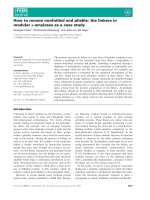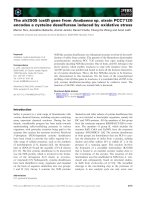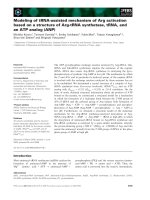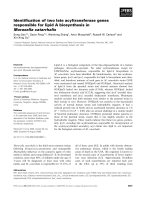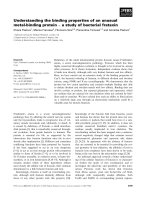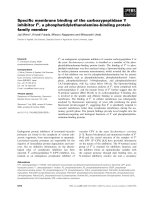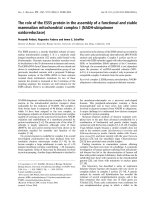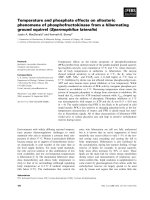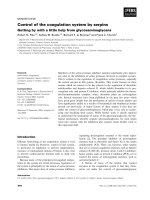báo cáo khoa học: "Interprofessional collaborative practice within cancer teams: Translating evidence into action. A mixed methods study protocol" potx
Bạn đang xem bản rút gọn của tài liệu. Xem và tải ngay bản đầy đủ của tài liệu tại đây (489.52 KB, 7 trang )
Implementation
Science
Tremblay et al. Implementation Science 2010, 5:53
/>Open Access
STUDY PROTOCOL
© 2010 Tremblay et al; licensee BioMed Central Ltd. This is an Open Access article distributed under the terms of the Creative Commons
Attribution License ( which permits unrestricted use, distribution, and reproduction in
any medium, provided the original work is properly cited.
Study protocol
Interprofessional collaborative practice within
cancer teams: Translating evidence into action. A
mixed methods study protocol
Dominique Tremblay*
1,2
, Danielle Drouin
3
, Ariella Lang
4
, Danièle Roberge
1,2
, Judith Ritchie
5
and Anne Plante
3
Abstract
Background: A regional integrated cancer network has implemented a program (educational workshops, reflective
and mentoring activities) designed to support the uptake of evidence-informed interprofessional collaborative
practices (referred to in this text as EIPCP) within cancer teams. This research project, which relates to the Registered
Nurses' Association of Ontario (RNAO) Best Practice Guidelines and other sources of research evidence, represents a
unique opportunity to learn more about the factors and processes involved in the translation of evidence-based
recommendations into professional practices. The planned study seeks to address context-specific challenges and the
concerns of nurses and other stakeholders regarding the uptake of evidence-based recommendations to effectively
promote and support interprofessional collaborative practices.
Aim: This study aims to examine the uptake of evidence-based recommendations from best practice guidelines
intended to enhance interprofessional collaborative practices within cancer teams.
Design: The planned study constitutes a practical trial, defined as a trial designed to provide comprehensive
information that is grounded in real-world healthcare dynamics. An exploratory mixed methods study design will be
used. It will involve collecting quantitative data to assess professionals' knowledge and attitudes, as well as practice
environment factors associated with effective uptake of evidence-based recommendations. Semi-structured
interviews will be conducted concurrently with care providers to gather qualitative data for describing the processes
involved in the translation of evidence into action from both the users' (n = 12) and providers' (n = 24) perspectives.
The Graham et al. Ottawa Model of Research Use will serve to construct operational definitions of concepts, and to
establish the initial coding labels to be used in the thematic analysis of the qualitative data. Quantitative and qualitative
results will be merged during interpretation to provide complementary perspectives of interrelated contextual factors
that enhance the uptake of EIPCP and changes in professional practices.
Discussion: The information obtained from the study will produce new knowledge on the interventions and sources
of support most conducive to the uptake of evidence and building of capacity to sustain new interprofessional
collaborative practice patterns. It will provide new information on strategies for overcoming barriers to evidence-
informed interventions. The findings will also pinpoint critical determinants of 'what works and why' taking into
account the interplay between evidence, operational, relational micro-processes of care, uniqueness of patients' needs
and preferences, and the local context.
Background
Context
Most cancer and palliative/end-of-life programs propose
interprofessional collaboration as a key modality for
improving quality of care [1-5]. The need for greater col-
laboration is being driven by the same pressures as those
driving the cancer services transformation agenda: the
pressure for timely access to care, lack of continuity in
care, needs unmet by current services, demand for sup-
portive care and dearth of health human resources. To
grapple with these issues, the regional cancer network in
* Correspondence:
1
Centre de Recherche Hôpital Charles LeMoyne, Greenfield Park, Quebec,
Canada
Full list of author information is available at the end of the article
Tremblay et al. Implementation Science 2010, 5:53
/>Page 2 of 7
Montérégie, a region in Quebec, Canada, has imple-
mented a program designed to expand existing interpro-
fessional collaboration among nurses, doctors, and other
care providers (pharmacists, nutritionists and social
workers) working on cancer teams.
The development of the 'Psychosocial oncology: Build-
ing interprofessional capacity to improve cancer care
across the continuum' program (referred to here as the
POBC
3
) was a nurse-led interdisciplinary project that was
funded by the Canadian Partnership against Cancer. A
summary of the program components is presented in
Table 1. This program, which is related to recommenda-
tions made in the Registered Nurses' Association of
Ontario (RNAO) Best Practice Guidelines [6,7] and other
sources of evidence [8-10], represents a unique knowl-
edge transfer initiative enabling local cancer team mem-
bers to experiment with EIPCP. We will use this program
to systematically examine the factors and processes
involved in the adoption of evidence-based recommenda-
tions and their adaptation into practices.
We define EIPCP as a transformative model for cancer
services delivery that engages care providers in the 'pro-
cess of working together to build consensus on common
goals, approaches and outcomes. It requires an under-
standing of own [sic] and others' roles, mutual respect
among participants, commitment to common goals,
shared decision making, effective communication, rela-
tionships and accountability for both the goals and team
members' [6]. EIPCP entails proactive strategies that
make care providers aware of evidence-based recommen-
dations and facilitate the translation of this knowledge
into day-to-day practice, as a basis for quality-of-care
improvement.
Translating evidence into action
The gap between research evidence on interprofessional
collaboration and practice is wide, well documented
[8,11], and troubling, especially in cancer services where
the cancer crisis jeopardizes the ability of health systems
to respond to patients' needs [1]. Even though collabora-
tion benefits users, providers, and organizations [12-14],
many professionals only pay lip service to the premise of
collaborative practice [15-17]. Previous studies have
emphasized key enablers of and barriers to interprofes-
sional collaboration: a lack of consensus about terminol-
ogy, the need for interprofessional collaboration
initiatives to have champions and external support, sensi-
tivity to the effects of profession-related cultures, and the
logistics of implementation [18]. Other barriers include
structural issues such as competition between profes-
sionals, and conceptual problems such as a lack of under-
standing of mutual roles and a lack of experience or
training in interdisciplinary collaboration among provid-
ers [14]. Less is known about how evidence-based recom-
mendations could be adopted and adapted by care
providers to overcome those barriers. Moreover, the pref-
erences of those using such services with regard to the
ways professionals work together and share the clinical
information are poorly understood and are understudied.
Theoretical background to use of research evidence
Multiple, interacting conditions pose a challenge to the
utilization of research findings. For practical reasons,
these conditions could be grouped under six main ele-
ments as proposed in the comprehensive Ottawa Model
of Research Use (OMRU) [19]. This model is an interdis-
ciplinary framework presenting the utilization of
research evidence as a dynamic process based on multi-
ple, interrelated decisions and actions. It has provided
guidance for numerous studies [20-22]. The OMRU
points to the importance of assessing barriers to the
translation of knowledge into action at three levels: the
characteristics of the recommendations made in the
guidelines (e.g., perceive usefulness, fit with current prac-
tice, norms/values), the characteristics of the profession-
als involved (e.g., awareness, attitudes, knowledge/skills,
concerns, current practice) and the characteristics of the
practice environment (e.g., users' preferences, work pres-
sure, competing demands/time) (Figure 1).
The literature on innovation and change in health ser-
vices [23-29] and RNAO documentation [6,30] will also
serve as conceptual background for our study. Our litera-
ture review led us to factor in the following four points:
the novelty of EIPCP should be considered from the per-
spectives of the individuals who experiment with new
ways of doing things; the players in the field have their
own interpretations of evidence and their own definitions
of the weaknesses in their practices they therefore have
intuitive ideas of what should be done to improve care
delivery, but it is difficult for them to drive change within
the context of their day-to-day activities; the mobilization
of multiple actors with different areas of expertise and
resources around a specific project focuses their efforts
and provides a better chance of success; and the evalua-
tion of an innovation contributes to its success it allows
the professionals involved in reflective activities to
develop their receptive capacity through doing. Overall,
the literature on innovation was used to define more
clearly the research aim and specific objectives. It will
also support data analysis, which will consist of matching
empirically observed EIPCP translation events to the the-
oretically predicted elements identified earlier.
Research aim and objectives
This study aims to examine the uptake of evidence-based
recommendations from best practice guidelines intended
to enhance interprofessional collaborative practices
within cancer teams. In this study, care providers are
Tremblay et al. Implementation Science 2010, 5:53
/>Page 3 of 7
Table 1: POBC multiple strategies and recommendations from RNAO documents
Improvement initiative POBC
3
multiple strategies
RNAO/BPG Recommendations
Participants discuss the components of collaborative practice to
understand what is involved and the underlying arguments. This
intervention arouses professionals' interests and helps to
determine goodness of fit with their local work environment.
Develop knowledge about the values and behaviours that support
teamwork and the impact of teamwork on patient/client safety and
patient/client outcomes. As such, nurses:
▪ Inform themselves about the attributes of supportive teams.
▪ Articulate their belief in the value of teamwork.
▪ Demonstrate their willingness to work effectively with others.
Participants are involved in reflective communication exercises,
and diverse educational strategies are employed to develop their
relational capacities. This strategy identifies enablers of and
barriers to effective communication.
Contribute to a culture that supports effective teamwork by:
▪ Demonstrating accountability for actions, enthusiasm, motivation,
and commitment to the team.
▪ Understanding own roles, scope of practice, and responsibilities, as
well as seeking information and developing an understanding
about other roles and scopes of practice.
▪ Being accountable for and respectful in the manner in which they
communicate.
Once participants identify a clinical situation of interest, they
discuss psycho-social interventions in a collaborative way.
Activities are conducted to ensure assimilation of the core
concepts by the participants in collaboration with a psychosocial
expert and two regional, trained professionals.
Teams establish clear processes and structures that promote
collaboration and teamwork that leads to quality work
environments and quality outcomes for patients/clients by:
▪ Establishing processes for conflict resolution and problem solving.
▪ Establishing processes to develop, achieve, and evaluate team
performance, common goals, and outcomes.
▪ Building capacity for systematic problem solving.
▪ Participating to the implementation of practices to support
enhanced collaboration at the functional and organizational level.
▪ Incorporating non-hierarchal, democratic working practices to
validate all contributions from team members.
Mentoring by professional experts target problem-solving
strategies, conflict resolution strategies to ensure sustainability of
learning in doing, and identify needs for further educational
workshop.
▪ Incorporating processes that support continuity of care with
patients/clients to enhance staff satisfaction, staff self-worth, and
patient/client satisfaction.
▪ Establishing processes for decision making for a variety of
circumstances such as:
• emergencies;
• day-to-day functioning;
• long-term planning;
• policy development;
• care planning
Assess participants' perceptions of their current inter-professional
functioning and provide feedback to each other.
Teams establish processes which promote open, honest, and
transparent channels of communication by:
▪ Establishing processes to ensure effective communication.
▪ Developing skills in active listening.
Tremblay et al. Implementation Science 2010, 5:53
/>Page 4 of 7
those directly or indirectly (clinicians, managers, deci-
sion-makers responsible for governance) involved along
the cancer trajectory, including community/home care,
specialized hospital and ambulatory cancer services, as
well as palliative/end-of-life care.
More specifically, our study objectives are as follows: to
assess how professional knowledge, beliefs and the prac-
tice environment support or impede the adoption of
EIPCP; to assess how patients' knowledge, beliefs and
needs influence this adoption process; and to describe
the impact of an educational workshop and mentoring
program on the uptake and sustainability of EIPCP over a
six- to eight-month period.
Methods
Design
The planned study constitutes a practical trial, defined as
a trial designed to provide comprehensive information
that is grounded in real-world healthcare dynamics [31].
An exploratory mixed methods design will be used [32].
This design will involve concurrent quantitative and
qualitative data collection and analysis. The quantitative
and qualitative results will then be merged to provide
complementary perspectives. The mixed methods design
will in turn allow us to form a more complete picture of
the interrelated contextual elements and the associated
individual characteristics that determine EIPCP than use
of a single method would allow (Figure 2) [33].
Participants and recruitment
The participants will be selected from two groups. The
care provider group (PG) will consist of professionals,
managers, and decision-makers responsible for gover-
nance at the regional level who are directly or indirectly
involved in the POBC
3
improvement initiative. The user
group (UG) will consist of patients/caregivers using ser-
vices at one of four care settings in the Montérégie cancer
network that are involved in the POBC
3
. Inclusion crite-
ria for the PG will include being: a key stakeholder knowl-
edgeable about POBC
3
planning, implementation and/or
evaluation, and a participant in the workshop and/or
mentoring activities of the POBC
3
. Inclusion criteria for
the UG will include being 18 years of age or older, able to
understand and communicate in French, and a current
user of cancer services at one of the participating care
settings. The potential PG participants will be recruited
during the POBC
3
workshop. They will be asked if they
agree to be contacted for a study on EIPCP and to provide
their contact information. For the UG group, field profes-
sionals will be asked to identify potential participants for
interviews using a purposive sampling strategy aimed at
maximum variability (e.g., age, gender, tumour site, stage
on the cancer trajectory) [34]. For users interested in par-
ticipating, a nurse who has extensive experience with
cancer patients will make the initial contact to obtain
their informed consent and conduct the interview.
Data collection
To meet objective one, quantitative data will be collected
from professionals using an adapted cancer care version
of the survey questionnaire from Davies' study on collab-
orative maternity care [35]. This questionnaire was con-
structed on the basis of the literature, which suggested
that the following issues should be considered in develop-
ing a survey tool in this field: the concepts that should be
demonstrated in a collaborative practice and the impor-
tance of the components of a collaborative practice
model. The questionnaire also includes the Attitude
toward Health Care Teams Scale [36], which contains two
subscales: quality of care/process (14 items, Cronbach's
alpha = 0.83) and physician centrality (six items, Cron-
bach's alpha = 0.68). Finally, a subscale (five items) taken
from the Interprofessional Collaboration Questionnaire
[37] will be used to assess the intensity of collaborative
practices. These questionnaires provide operational mea-
sures that will be used to assess potential adopters'
knowledge, attitudes, beliefs and current practice as
described in the OMRU. To meet objective three, which
focuses on the sustainability of practice over time, the
questionnaire will be administered at the end of the
POBC
3
two-day workshop (T1) and six to eight months
later after a period of mentoring (T2). This time frame
was adopted first because the POBC
3
is currently under-
way and pre/post-measurements are therefore not possi-
ble. Second, it was important to ensure a minimal sample
size at T2 by taking potential workforce turnover into
account.
Concurrently with T2, we will collect qualitative data to
deepen our understanding of service users' perspectives
(objective two), the contextual factors and the processes
determining EIPCP patterns. In-depth interviews (60
Figure 1 Theoretical framework. Adapted from Graham & Logan
[19].
Assess
Barriers & Supports
Monitor
Degree of use
Evaluate
Outcomes
Recommendations
from BPGs
Collaborative
Practice
Adopters
Nurses and other
professionals
• Attitudes
• Beliefs
•Practices
Work Environment
• Workload
• Competing
demands
Multi-faced Intervention
Interactive educational
workshop
• Reflective learning
• Feedback
• Mentoring
Adoption
Collaborative
practice in action
Evaluation
•Patients
• Professionals
• Organizations
•Systems
+
+
Tremblay et al. Implementation Science 2010, 5:53
/>Page 5 of 7
minutes) will be conducted to gain understanding of the
experience, the challenges, and the insights of both ser-
vice users (n = 16) and care providers (n = 24). We will
use a systematic interview guide adapted from Edwards'
[38] and Peterson's [17] previous works on best practice
guidelines implementation. The interviews will be audio-
taped. With assistance from the care settings, we will pur-
posefully select archival material that provides records of
the EIPCP process. By way of example, documents will
include reports, protocols and procedures, aggregated
and non-identifiable patient reports, information sheets,
minutes of meetings, and other relevant print material.
No information from individual patient records will be
collected.
Sample size
Approximately 100 professionals and managers are
involved in POBC
3
activities. Based on our previous stud-
ies [39,40], we anticipate a participation rate of 80% for
our planned survey, leaving us with an a priori sample
size of 80. The Power Analysis and Sample Size (PASS
2008) software was used to determine the sample size
required for testing differences between groups. Assum-
ing a type-one error rate of 5%, a minimal estimated sam-
ple size of 51 participants per group will give 80% power
to detect a medium effect size using Cohen's guidelines
[41]. The sample size for interviews was determined on
the basis of Guest's and his colleagues' experiment, which
demonstrated that data saturation occurs primarily after
12 interviews (UG) [42], and taking into account multiple
investigation sites (PG).
Analysis
Quantitative data will be managed using the SPSS. We
will conduct an assessment of the validity of the question-
naire with our sample using principal component analysis
and analysis of internal consistency [43,44]. We will then
generate descriptive statistics (frequency, mean, and SD)
and perform comparative analyses between groups (using
the t-test and Mann-Whitney test) to identify PG (T1-T2)
differences (p < 0.05, IC 95%) [44]. Qualitative data from
interview transcripts and documents will be managed
using a formal database using QSR NVivo [45]. Thematic
content analysis, using a theoretical orientation strategy,
will guide the open-ended coding procedure in order to
identify, classify, and reduce data and to build a descrip-
tive matrix [46,47]. The initial coding labels will be estab-
lished by building on the elements of the OMRU. Table 2
presents a list of these elements and short definitions that
describe the coding labels. In order to monitor collabora-
tive practice change following the POBC
3
, we will focus
on operational processes (how team members provide
care), relational processes (how team members commu-
nicate), and adaptive processes (how team members use
evidence to enhance collaborative practice) [48].
The trustworthiness of our research data and analysis
will be ascertained using Miles and Huberman's criteria
of credibility/validity, confirmability/objectivity, and
transferability [46]. Given that our study will be an ex-
post intervention study [49] and that the sampling
method constitutes one of its limitations, the internal
validity will be increased by use of a theoretical frame-
work, validated investigation tools previously used by
best practice guideline expert researchers, systematic
data collection and analysis methods, as well as triangula-
tion [50]. An audit trail of the entire research process will
be kept [51].
Ethics
The study has been approved by the Centre de Recherche
de l'Hôpital Charles LeMoyne Ethics Board (ref. number
AA-HCLM-09-034).
Conclusions
This study will constitute a practical trial [52] that takes
into account the context-specific challenges and the con-
cerns of nurses and other stakeholders regarding use of
evidence-based recommendations. Building on an ongo-
ing improvement initiative, our study represents a unique
opportunity for examining the translation of RNAO best
practice guidelines into action. POBC
3
planned educa-
tional workshops and mentoring activities will produce
new knowledge on the interventions and sources of sup-
port most conducive to the uptake of evidence and build-
ing of capacity to sustain new interprofessional
collaborative practice patterns. It will provide new infor-
mation on strategies for overcoming barriers to the adop-
tion of evidence-informed interventions. The findings
will also pinpoint new determinants of 'what works and
why,' given the interplay between the general application
Figure 2 Mixed methods integration. * Saldana [47]. ** Miles & Hu-
berman [46].
Matrix elaboration for descriptive
explanation**
Second reading and coding by 2
independent coders
Coding quality control (10% of the
material, 2 independent coders, 85%
consensus)*
Coding grid adaptation
First reading and coding round
Open-ended coding grid based on OMRU
and team consensus codebook
Interview transcription and documents
QSR N’VIVO data base
Qualitative data
Interpretation and recommendations for decision makers and further research
Integration of QUAL + QUANT results
t-test (interval data)
Mann-Withney test (ordinal data)
ANOVA (interval data)
T1-T2 inter group difference
Descriptive statistics
(minimum, maximum, mean, SD)
Group comparison
Survey questionnaire data
SPSS data base
Quantitative data
Tremblay et al. Implementation Science 2010, 5:53
/>Page 6 of 7
of evidence, uniqueness of cancer patient'/caregivers'
needs and preferences, and the local context. It will pro-
vide new knowledge on strategies for making care provid-
ers aware of evidence-based recommendations from best
practice guidelines and others sources of information.
This knowledge will contribute to the refinement of con-
tinuing education programs, and will add new dimen-
sions to existing survey instruments that assess
knowledge, beliefs, and practices regarding evidence-
informed interventions.
Competing interests
The authors declare that they have no competing interests.
Authors' contributions
The study was initially conceived of by DT and DD. All contributing authors
were involved in defining the study design and adapting both the question-
naire and interview grid. The manuscript was written by DT and DD, with all
authors both contributing to its development and completion and approving
the final version.
Acknowledgements
The study received a research grant from the Canadian Nurses Foundation
through the Nursing Care Partnership Program, which focuses on RNAO Best
Practice Guidelines />79/language/en-US/Default.aspx. Hôpital Charles LeMoyne is the decision-
maker research partner of the study, and provides financial and institutional
support through the Centre intégré de cancérologie de la Montérégie http://
www.santemonteregie.qc.ca/hclm/index.fr.html.
Author Details
1
Centre de Recherche Hôpital Charles LeMoyne, Greenfield Park, Quebec,
Canada,
2
Faculty of Medicine and Health Sciences, Université de Sherbrooke,
Longueuil, Québec, Canada,
3
Hôpital Charles LeMoyne, Centre intégré de
cancérologie de la Montérégie, Greenfield Park, Quebec, Canada,
4
Victorian
Order of Nurses, VON Canada National Office, Ottawa, Ontario, Canada and
5
McGill University Health Centre & School of Nursing, McGill University,
Montreal, Quebec, Canada
References
1. Canadian Strategy for Cancer Control: Why the need for a shift in focus in
our cancer care system? Canadian Strategy for Cancer Control Bulletin
2005, 1:1-4.
2. World Cancer Declaration 2008. Global crisis [ />index.php?option=com_content&task=view&id=16525&Itemid=566]
3. The NHS cancer plan and the new NHS: Providing a patient-centred
service [ />Publications/PublicationsPolicyAndGuidance/DH_4092531]
4. National cancer control programmes. Policies and managerial
guidelines [ />5. Avis sur les équipes interdisciplinaires en oncologie [http://
www.msss.gouv.qc.ca/sujets/prob_sante/cancer/
download.php?f=e899a549fb5483bca704b9f28a7e03ec]
6. Collaborative Practice Among Nursing Teams [ />Storage/23/1776_BPG_Collaborative_Practice.pdf]
7. Nursing Best Practice Guidelines [ />Page.asp?PageID=861&SiteNodeID=133]
8. Health Professions Regulatory Advisory Council: Interprofessional
Collaboration. A summary of key reference documents & selected
highlights from the literature. Toronto: Health Professions Regulatory
Advisory Council; 2008.
9. Zwarenstein M, Goldman J, Reeves S: Interprofessional collaboration:
effects of practice-based interventions on professional practice and
healthcare outcomes. Cochrane Db of Syst Rev 2009.
Received: 26 April 2010 Accepted: 13 July 2010
Published: 13 July 2010
This article is available from: 2010 Tremblay et al; licensee BioMed Central Ltd. This is an Open Access article distributed under the terms of the Creative Commons Attribution License ( which permits unrestricted use, distribution, and reproduction in any medium, provided the original work is properly cited.Implementation Science 2010, 5:53
Table 2: Elements of the OMRU with short definitions of
coding labels
Elements Short definitions
A. Assess barriers and supports
Local context
• Work environment Factors such as rules, regulations,
available resources, and support
• Work pressure Fit between EIPCP work load and
receptivity of involved professionals
• Competing demands Multiple pressures calling for practice
change and importance of EIPCP and
time constraints
Recommendations form
BPGs
• Intervention source Professionals' perception of whether
the EIPCP is an externally or internally
driven intervention
• Benefits ratio Professionals' perception of the added
value for themselves and for the
service users
• Adaptability The extent to which
recommendations can be adapted to
fit the dynamics of the local context
• Usefulness Perceived usefulness of
recommendations from BPGs and
others sources of evidence
Adopters
• Knowledge Professionals' definition and concepts
related to collaborative practice and
anticipated outcome of EIPCP
• Current practice Fit between EIPCP, perceived quality
of care process and shared decision
making
• Beliefs/Attitudes Value that professionals place on
EIPCP and perception of
responsibilities regarding care
B. Monitor degree of use
• Operational
processes
Sequence of events illustrating how
cancer team members perform
collaborative care planning and
shared decision making,
• Relational processes Sequence of events illustrating how
cancer team members interact,
communicate and negotiate shared
intervention zone
• Adaptive processes Sequence of events illustrating how
cancer team members enact changes
in order to enhance collaborative
practices
Tremblay et al. Implementation Science 2010, 5:53
/>Page 7 of 7
10. Association of Ontario Health Centers [AOHC]: Building better teams: A
toolkit for strengthening teamwork in community health centres.
Canadian Alliance of Community Health Centre Associations; 2007.
11. D'Amour D, Beaulieu MD, San Martin Rodriguez L, Ferrada-Videla M: Key
elements of collaborative practice & frameworks: conceptual basis for
interdisciplinary practice. In Interdisciplinary education for collaborative
patient-centred practice Research and findings report Ottawa: Health
Canada; 2004:64-98.
12. San Martin Rodriguez L: Évaluation des effets de la collaboration
interprofessionnelle chez les professionnels et chez les patients dans
les unités d'hospitalisation en oncologie et en hématologie. In Thèse de
doctorat Université de Montréal, Faculty of Nursing; 2007.
13. Lemak CH, Johnson C, Goodrick EE: Collaboration to improve services
for the uninsured: exploring the concept of health navigators as
interorganizational integrators. Health Care Manage Rev 2004,
29:196-206.
14. Teamwork in healthcare: promoting effective teamwork in healthcare
in Canada [ />synthesis-report_e.pdf]
15. Thornhill J, Dault M, Clements D: CHSRF knowledge transfer: ready, set
collaborate? The evidence says 'Go'; so what's slowing adoption of
inter-professional collaboration in primary healthcare? Healthcare
Quarterly 2008, 11:14-16.
16. Interprofessional collaboration []
17. Peterson W, Medves J, Davies B, Graham I: Multidisciplinary collaborative
maternity care in Canada: easier said than done. JOGC 2007,
29:880-886.
18. Norris SL, Nichols PJ, Caspersen CJ, Glasgow RE, Engelgau MM, Jack L,
Isham G, Snyder SR, Carande-Kulis VG, Garfield S, et al.: The effectiveness
of disease and case management for people with diabetes. A
systematic review. Am J of Prev Med 2002, 22:15-38.
19. Graham I, Logan J: Innovations in knowledge transfer and continuity of
care. CJNR 2004, 36:89-103.
20. Logan J, Harrison MB, Graham ID, Dunn KB, J: Evidence-based pressure-
ulcer practice: The Ottawa Model of Research Use. CJNR 1999, 31:37-52.
21. Protheroe J, Bower P, Chew-Graham C: The use of mixed methodology
in evaluating complex interventions: identifying patient factors that
moderate the effects of a decision aid. Fam Pract 2007, 24:594-600.
22. Logan J, Graham I: Toward a comprehensive interdisciplinary model of
health care research use. Sci Commun 1998, 20:27-246.
23. Denis J-L, Hébert Y, Langley A, Lozeau D, Trottier LH: Explaining diffusion
patterns for complex health care innovations. Health Care Manage Rev
2002, 27:60-73.
24. Fitzgerald L, Ferlie E, Wood M, Hawkins C: Interlocking interactions, the
diffusion of innovations in health care. Hum Relat 2002, 55:1429-1449.
25. Greenhalgh T, Robert G, Bate P, Mcfarlane F, Kiriakidou O: Diffusion of
innovations in health service organisations. Massachusetts: Blackwell
Publishing; 2005.
26. Fleuren M, Wieffernink K, Paulussen T: Determinants of innovation within
health care organizations. Literature review and Delphi study. Int J
Qual Health C 2004, 16:107-123.
27. Länsisalmi H, Kivimäki M, Aalto P, Ruoranen R: Innovation in healthcare: a
systematic review of recent research. Nur Sc Quart 2006, 19:66-72.
discussion 65
28. Reay T, Golden-Biddle K, Germann K: Legitimizing a new role: Small wins
and microprocesses of change. Acad of Manage J 2006, 19:977-998.
29. Potvin L, Golberg C: Deux rôles joués par l'évaluation dans la
transformation de la pratique en promotion de la santé. In Promotion
de la santé au Canada et au Québec, perspectives critiques Edited by: O'Neil
M, Dupéré S, Pederson A, Rootman I. Québec: Presses de l'Université Laval;
2006:457-473.
30. Toolkit. Implementation of clinical guidelines [ />Storage/12/668_BPG_Toolkit.pdf]
31. Oxman AD, Lombard C, Treweek S, Gagnier JJ, Maclure M, Zwarenstein M:
Why we will remain pragmatists: four problems with the impractical
mechanistic framework and a better solution. J Clinical Epidemio 2009,
62:485-488.
32. Creswell JW, Plano Clark VL: Designing and conducting mixed methods
research. London: Sage; 2007.
33. Morse JM: Approaches to qualitative-quantitative methodological
triangulation. Nur Res 1991, 40:120-123.
34. Patton MQ: Qualitative research & evaluation methods. 3rd edition.
Newbury Park: Sage Publications; 2001.
35. Assessing knowledge attitudes and beliefs towards collaborative
primary maternity care. Module 6 Evaluating the collaborative model
[ />36. Heinemann GD, Schmitt MH, Farrell MP, Brallier SA: Development of an
Attitudes toward Health Care Teams Scale. Eval Health Prof 1999,
22:123-142.
37. Sicotte C, D'Amour D, Moreault M: Interdisciplinary collaboration within
Quebec cummunity health care centers. Soc Sci and Med 2002,
55:991-1003.
38. Evaluation of Nursing Best Practice Guidelines: Interviewing Nurses
and Administrators [ />CHRU_Monograph_Series_M04-1.pdf]
39. Assessement of the integrated network of oncology care and services:
the Montérégie experience [ />pdf/roberge_2_e.pdf#search=%22vignette%20cazale%20tremblay%22]
40. Tremblay D: La traduction d'une innovation organisationnelle dans les
pratiques professionnelles de réseau: L'infirmière pivot en oncologie.
Université de Montréal, Faculty of Nursing; 2008.
41. Cohen J: Statistical power analysis for the behavior sciences. 2nd
edition. Hillsdalem, NJ: Erlbaum; 1988.
42. Guest G, Bunce A, Johnson L: How Many Interviews Are Enough?: An
Experiment with Data Saturation and Variability. Field Methods 2006,
18:59-82.
43. Conway JM, Huffcutt AI: A review and evaluation of exploratory factor
analysis practices in organizational research. Organl Res Methods 2003,
6:147-168.
44. Field A: Discovering statistics using SPSS. 2nd edition. Thousand Oaks:
Sage Publications; 2005.
45. Richards L: Using NVivo in qualitative research. London: Sage; 1999.
46. Miles MB, Huberman AM: Analyse des données qualitatives. Paris: De
Boeck; 2003.
47. Saldana J: The coding manual for qualitative researchers. Thousand
Oaks: Sage Publications; 2009.
48. McGrath JE, Tschan F: Dynamics in groups and teams. In Handbook of
organizational change and innovation Edited by: Poole MS, Van de Ven AH.
New York: Oxford University Press; 2004:50-72.
49. Contandriopoulos A-P, Champagne F, Potvin L, Denis J-L, Boyle P: Savoir
préparer une recherche, la définir, la structurée, la financer. Montreal:
Les presses de l'Université de Montreal; 1990.
50. Hanson WE, Creswell JW, Plano VL, Petska KS, Creswell JD: Mixed Methods
Research Designs in Counseling Psychology. J of Couns Psychol 2005,
52:224-235.
51. Guba AEG, Lincoln YS: Forth generation evaluation. Newbury Park: Sage
Publications; 1989.
52. Glasgow RE, Emmons KM: How can we increase translation of research
into practice? Types of evidence needed. Annu Rev of Publ Health 2007,
28:413-433.
doi: 10.1186/1748-5908-5-53
Cite this article as: Tremblay et al., Interprofessional collaborative practice
within cancer teams: Translating evidence into action. A mixed methods
study protocol Implementation Science 2010, 5:53
